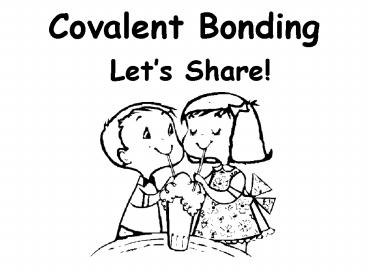Covalent Bonding - PowerPoint PPT Presentation
1 / 15
Title:
Covalent Bonding
Description:
Diatomic Molecules. Two IDENTICAL elements with a covalent bond. ... There are diatomic elements, and they form the on the periodic table. Naming Covalent Compounds ... – PowerPoint PPT presentation
Number of Views:196
Avg rating:3.0/5.0
Title: Covalent Bonding
1
Covalent Bonding
- Lets Share!
2
Covalent Bonds
- A covalent bond is a force between atoms that
SHARE valence electrons to get a full octet. - Occur between 2 or more non-metals.
- AKA Molecular Bond/Molecular Componds
3
Covalent Bonds Continued. . .
- Covalent bonds are in lipids (fats),
carbohydrates, proteins, and petroleum. These
covalent compounds all contain carbon so they are
all organic!
4
Diatomic Molecules
- Two IDENTICAL elements with a covalent bond.
5
- Diatomic molecules occur in nature this way
because - they are more stable than
- one atom alone.
6
MEMORIZE these diatomic molecules
- Hydrogen H2
- Oxygen O2
- Bromine Br2
- Fluorine F2
- Iodine I2
- Nitrogen N2
- Chlorine Cl2
In HCl, neither the H or Cl is a diatomic b/c it
is NOT ALONE!
7
Remember
- The HOBrFINCl twins!!! ?
8
There are diatomic elements, and they form the
on the periodic table.
9
Naming Covalent Compounds
You mean we have to name these, too??
10
- First Name the first element.
- Use a prefix to indicate the number of atoms it
has. - If there is only one atom of the first element,
do NOT use a prefix!
11
MEMORIZE THESE PREFIXES
- When oxygen is involved. . .
- Drop the a and o from the prefixes above!
- Example
- monoxide NOT monooxide
- heptoxide NOT heptaoxide
- decoxide NOT decaoxide
- ________ NOT nonooxide
- ________ NOT octooxide
mono
di
tri
tetra
penta
hexa
hepta
octa
nonoxide
nona
octoxide
deca
12
Next Name second element.
- Change the ending to ide.
- Use a prefix to indicate the number of atoms.
- You must use a prefix for the second element,
even if there is only one atom!
USE A PREFIX
13
One last tip
- NEVER, EVER, EVER reduce a covalent compound!
dicarbon hexachloride
C2Cl6
If you reduce it
C1 Cl3
carbon trichloride
These are NOT the same compounds!
14
The last tip . . . I promise! ?
- NEVER criss-cross numbers of atoms!
- You only do that for OXIDATION NUMBERS with ionic
compounds! - Covalent compounds dont have oxidation numbers
because they dont lose/gain e- -- they SHARE!
15
Had Enough???? Try the practice problems!































